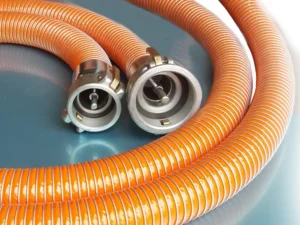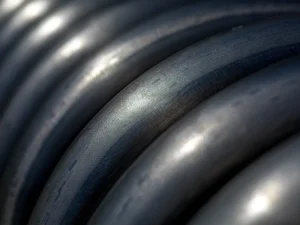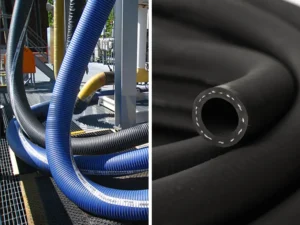Are you looking for what makes a hose different from others? What features matter the most to you when considering a hose for your projects? Then this guide (composite hoses vs rubber hoses) can be handy in your research.
A wide range of hoses and materials are available on the market. Composite hoses and rubber hoses are two popular types. Customers often ask us what a composite hose is and why they should use it. Here’s a quick guide on composite hoses vs rubber hoses.
Both composite hoses and rubber hoses are trendy. Each type offers unique advantages and limitations, which means they have unique uses in different sectors.
This article compares their designs and structures, how they are made, and what they are used for. If you know what makes them different, you can pick the right one for the job.
What are Composite Hoses?

When vulcanization was invented, people used raw rubber to make rubber products. However, they had found a way to make rubber more pliable, resilient, and long-lasting. To do this, they used sulfur along with the vulcanization process. Well, that’s great, and it has led to more shoes, hoses, tires, and so forth.
The vulcanization process needs raw rubber. At the time, people could only find it on trees. They didn’t have synthetic rubber yet and probably won’t for another hundred years.
Between 1890 and 1900, a patent was filed in London on “wire-bound hose.” This is the first-generation composite hose.
Composite hoses are flexible and multi-layered. They don’t require rubber at all. People use different materials other than rubber to make composite hoses. Thermoplastics, fabrics, and metallic wires are commonly used in making these hoses.
Composite hoses are mostly famous for their spiral wires. There are both internal and external spiral wires. So, what you see on the outside is also on the inside. On top of the first wire layer is a vapor barrier that looks like plastic wrap. Then, there’s some reinforcement polyester layer. Then, there’s a cover made of nylon or other materials. Typically, all these materials are color-coded on top of the hose.
What are Rubber Hoses?

Rubber hoses are tubes or pipes used to transport liquids or air. They are made of natural or synthetic rubber. In most cases, synthetic materials are prevalent for making rubber hoses. EPDM, neoprene, nitrile, and silicone rubber are common types of synthetic rubber. The correct type usually depends on your project requirements.
Each rubber type offers unique advantages. Natural rubber offers excellent elasticity. Neoprene resists abrasion, oil, and weathering. NBR is great for oil resistance. Silicone rubber provides extreme heat resistance. Finally, EPDM is great for weathering and UV exposure. The properties of each rubber determine whether you can use it in your applications.
Rubber hoses are reliable, flexible, valuable, and widely used in many fields. They may convey air, water, chemicals, and more. In the construction sector, they move concrete, plaster, and grout.
Composite Hoses vs Rubber Hoses: What’s the Difference?

Both rubber hoses and composite hoses are trendy in industrial use. Each offers unique advantages, and due to this, you may find their different applications. Look at the following table for a quick review of their differences. In the later section, we will briefly discuss its aspects.
| Aspect | Composite Hoses | Rubber Hoses |
| Material Composition | Multiple Layers, including plastic or thermoplastic barrier, metal helices | Made of rubber compounds, including natural or synthetic rubber |
| Flexibility | Generally flexible | Also, flexible but stiffness varies |
| Chemical resistance | Excellent resistance to chemical | Chemical resistance varies depending on the type of rubber used |
| Temperature Resistance | Can withstand a broad range of temperatures | Varies depending on the type of rubber materials |
| Pressure ratings | It can handle high pressures due to its multi-layer structure. | Some rubbers are great for high pressures, while some aren’t |
| Weight | Relatively lightweight | It can be heavier than composite hoses |
| Cost | Generally, they are more expensive than rubber hoses | Often more cost-effective |
| Applications | Chemical transfer, oil and petroleum handling, marine applications | Widely used across automotive, industrial, construction, and more |
Composite Hoses vs Rubber Hoses: Design
Composite Hoses
The Composite hoses usually have four main layers: inner, reinforcement, barrier, and outer. Each layer has a specific job.
The innermost layer is often made of polypropylene, polyethylene, or PTFE. However, different materials can also be used for this layer. The inner layer provides chemical resistance and smooth fluid flow.
The reinforcement layer surrounds this inner layer. This layer may have different materials, but it will always be metals. The internal spiral wire makes the tube of the hose. It generally stops the hose from collapsing under the vacuum. The external wire gives the hose PSI and its burst strength.
The material of these helices could be stainless steel or galvanized steel, depending on your requirements.
The end fittings are typically male pipe threads. You could also put a flange, C, E, or groove end. It depends on your specifications and application details. Usually, these composite hoses come with pipe thread, mostly 10—or 20-footers.
Rubber Hoses
Rubber tubes usually have three layers: an inner, middle, and outer layer. Every layer serves a unique function.
First, the inner layer conveys the fluid. Since it comes into contact directly with the conveyed fluid, the material in this layer must be compatible.
The middle layer makes the whole thing strong. Strengthening materials like nylon, polyester, or metal wire bands are often added to this layer. These materials make the hose stronger, last longer, and less likely to break under pressure.
Lastly, the layer on the outside, mostly made of rubber, protects against wear and tear, weathering, and damage from the outside.
Composite Hoses vs Rubber Hoses: Performance
Composite hoses are much lighter. A comparable two-inch rubber hose would weigh quite a bit more than composite hoses. Besides, composite hoses are very flexible.
Another advantage is that when the composite hose begins to fail, you will see it seep or occasionally drip. However, you will not have a catastrophic failure with a composite hose.
Rubber hoses, on the other hand, are also flexible, but stiffness may vary. For example, natural rubber is highly adaptable. Certain rubbers come into play when you talk about chemicals. Neoprene and NBR are great for oil, fuel, and grease resistance. Besides, rubber can be heavier than composite hoses.
Both types can handle high pressure. However, composite hoses have higher pressure ratings.
Composite Hoses vs Rubber Hoses: Manufacturing Method
Composite hoses have many layers. It is made from thermoplastic fabrics and films. These layers are wrapped in a spiral shape and supported by wires inside and outside the hose. This design gives the hose a strong structure.
However, there are different ways to make rubber tubes. Extrusion, calendaring, and molding are the most popular methods. Each method has its own challenges and affects the strength and durability of the hose.
Composite Hoses vs Rubber Hoses: Fluid Transfer Compatibility
When moving fluids, it’s essential to ensure the hose’s material is compatible. Composite hoses offer versatility. They can convey a wide range of chemicals. People often use them for chemical transfers.
Rubber hoses might not be able to handle all chemicals. However, they are also trendy for specific applications. For instance, neoprene and NBR are great for moving fuels, oils, and grease.
Therefore, you must choose a suitable hose material to ensure safety and efficient fluid transfer.
Composite Hoses vs Rubber Hoses: Pressure Control
Composite and rubber hoses are not the same when controlling pressure. Their construction determines how much power they can hold.
For strength, composite hoses have layers of different materials. Most rubber tubes don’t have as many layers. These layers change the hose’s ability to hold pressure. The construction of the hose also plays a role.
Composite hoses are often more flexible, making it easier to control the pressure.
Composite Hoses vs Rubber Hoses: Ease of Operations
The Composite hoses are relatively lighter than rubber hoses. As mentioned, you can connect composite hoses in several ways: thread, flange, C, E, or fittings. Therefore, composite hoses are easy to install and maneuver.
Both types of hoses are easy to install. However, their lighter weight and increased flexibility make them easier to position and connect.
Composite Hoses vs Rubber Hoses: Application
Composite and rubber hoses differ in several ways. Because they are different, you can use them for various tasks.
Composite hoses are ideal for transporting strong chemicals and volatile substances. Their layered design makes them very popular in the chemical, petroleum, and petrochemical sectors. They may also be used in the marine, moving liquids on board ships.
Rubber hoses are great for moving hydraulic fluids, water, and air. They are often found in agriculture, manufacturing, the car industry, and other industrial settings. Rubber hoses last a long time and are flexible. They come in a wide range of types and sizes. You can decide on the right type and size based on your application.
Contact Us Today
Composite and rubber hoses are flexible and highly versatile. You can choose the type of material for the inside and outside layers based on your application requirements. We, a leading composite hose manufacturer, offer all kinds of combinations.
Please contact us if you have questions or need help choosing a hose for your application. Our team of experts is ready to help you figure
